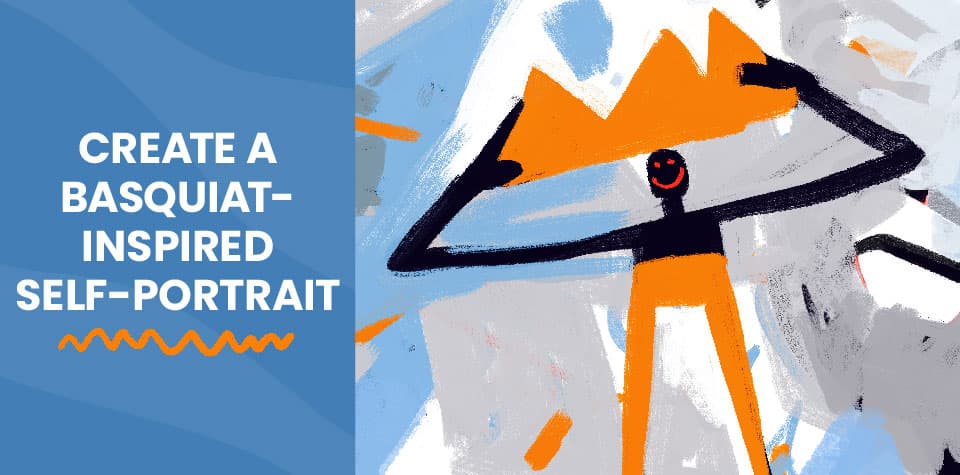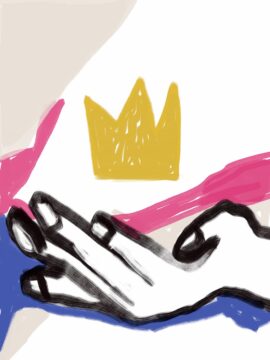
Create a Basquiat-Inspired Self-Portrait
Jean-Michel Basquiat hit the art world like a thunderclap in the 1980s. A native of Brooklyn, New York, he became a prominent and prolific creator who challenged the art world and pointed out injustice. Known for an energetic, bold style and artworks filled with vivid imagery and layers of meaning, he created close to a thousand paintings and thousands of drawings. Looking at his artwork with your children can jump-start a conversation about how they can use art to share their feelings about the world around them.
Kids can also celebrate Basquiat’s art by making their own self-portraits inspired by his style. (Basquiat’s self-portraits are some of his best-known works.) All they need are a piece of paper and colored pencils or pastels.
Make a Basquiat-Inspired Self-Portrait
One of the lessons kids can take from Basquiat’s art is that it doesn’t always take a lot of fancy tools to make great art with a deep and important message. Making their own self-portraits with a few simple art supplies can help kids discover the power of artistic expression for themselves.
Supplies
Drawing paper
Colored pencils or pastels
Instructions
Basquiat sometimes used bright colors for his backgrounds, so filling the page with color blocks can be a good way to start. Other Basquiat self-portraits use scribble-like lines or words behind the main image. Kids can follow their hearts (and abilities) on the first step!
Step 1: Kids create backgrounds on the paper using colored pencils or pastels.
Step 2: Kids draw a picture of themselves over their background. To help it stand out, they should aim for high contrast. If they use bright colors for the background, they should use a dark color for their self-portrait. If they use darker colors in the background, they may need to use white for the self-portrait.
Step 3: Kids add images to their self-portrait. What things are important to them? What objects represent challenges and triumphs in their lives? Adding these things to the self-portraits can help them start to understand how artists use symbols to tell stories.
The Basquiat Crown

We suggest having kids add images to their Basquiat-inspired self-portraits because the artist himself did that a lot. One of Basquiat’s most frequently used and famous images was of a three-pointed golden crown.
Artists and art scholars don’t always agree on what the crowns in Basquiat’s art mean. They don’t always look exactly the same, and he used a lot of them. But most people think he often used them to draw attention to Black people (including himself) he thought deserved respect for their achievements.
The Basquiat crown became such a signature mark of the artist that when he died, his friend and fellow artist Keith Haring painted a pile of crowns as a tribute to him.
The Basquiat Dinosaur
The “Basquiat dinosaur” is another famous, enduring image from the artist’s collection of work. It’s actually entitled Pez Dispenser and shows a black, red-eyed, cartoonish dinosaur with a golden crown on its head.
Like most of Basquiat’s art, the dinosaur is open to interpretation. It could be a criticism of the way art was consumed (like the Pez™ candy in the title) in the 1980s. Or it could mean something else. Whatever the meaning, it’s a great example of the power of art to connect with people and of the way simple images can suggest complex meanings.
Make Your Own Meanings
Now that you’ve had a chance to explore the meanings of some of Basquiat’s best-known works of art, there’s a great opportunity for kids to take another look at their own self-portraits and try another approach. Have them sketch out different ideas (just as artists often do) before they settle on their next design. Invite them to consider:
- How might changing the size of their self-portrait change the way it makes them feel? What if they made the self-portrait take up almost the whole page? What if it took up only a small corner of the paper?
- How would changing the colors change the way the drawing looks? Switching a bright background for a dark one (or the other way around) can completely change the way a person feels when they look at an image.
- What would happen if they changed the way the drawing faces? If their self-portrait was sideways instead of facing front, what might that make the painting say?
The world of art offers endless opportunities for exploration. You and your family can get creative with sidewalk chalk, make a puffy painting, or try at-home art activities inspired by cultures around the world!
